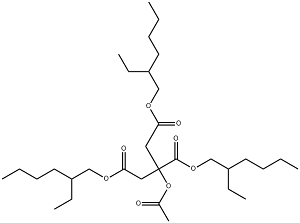Acetyl Triethylhexyl Citrate

Product Description
Acetyl Triethylhexyl Citrate is a non-toxic, biodegradable plasticizer derived from citric acid. It is widely used in various industries due to its excellent compatibility with polymers and eco-friendly profile.
Product:
Acetyl Triethylhexyl Citrate
CAS:
144-15-0
Synonym:
Acetyl tris(2-ethylhexyl) citrate; 1,2,3-Propanetricarboxylic acid, 2-(acetyloxy)-, tris(2-ethylhexyl) ester; Tris(2-ethylhexyl); 2-(acetyloxy)propane-1,2,3-tricarboxylate
Structure:

Typical Characteristics
Appearance
Colorless oily liquid
Boiling point
228-229 °C/100 mmHg
Density
1.136 g/cm3
Melting point
-42 °C
Molecular Weight
570.80
Odor
Odorless
Purity
99%
Refractive index
1.439
Uses, Applications & Markets
Key applications
get a quote
We Offer Acetyl Triethylhexyl Citrate
in various grades
A few of the grades available are listed below:



Acetyl Triethylhexyl Citrate used in many
industry applications
Acetyl Triethylhexyl Citrate is a non-toxic, biodegradable plasticizer derived from citric acid. It is widely used in various industries due to its excellent compatibility with polymers and eco-friendly profile. Below are its key industrial applications:
- Plasticizer: Used as a primary plasticizer in PVC, bioplastics, and other polymer applications to enhance flexibility and durability.
- Cosmetics and Personal Care: Functions as a safe alternative to phthalate plasticizers in nail polish, perfumes, and skin care formulations.
- Medical and Pharmaceutical: Employed in medical-grade plastics for applications such as IV bags, tubing, and flexible medical devices due to its non-toxic nature.
- Food Packaging: Used in food contact materials and coatings to improve flexibility without releasing harmful chemicals.
- Adhesives and Sealants: Enhances the performance and elasticity of adhesives, sealants, and coatings in industrial applications.
- Printing Inks: Utilized as a plasticizer in ink formulations to improve adhesion and print quality.
- Coatings and Paints: Acts as a plasticizer in water-based and solvent-based coatings to enhance film formation and flexibility.
- Textile Industry: Used in textile treatments to improve softness and resilience of fabrics.
- Children’s Products: Preferred in toys and baby products as a safer alternative to traditional plasticizers.
- Agriculture: Used in biodegradable mulch films and other eco-friendly agricultural applications.